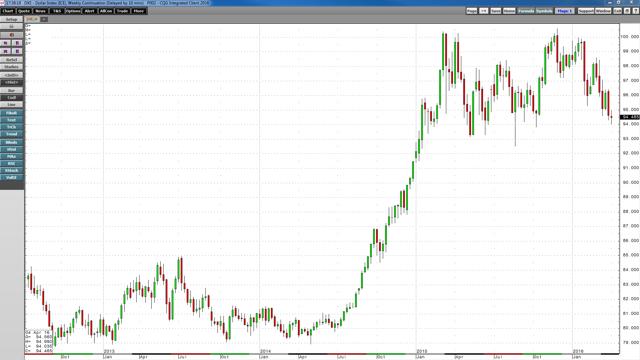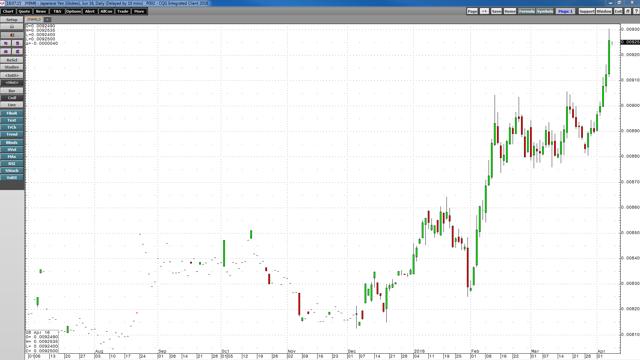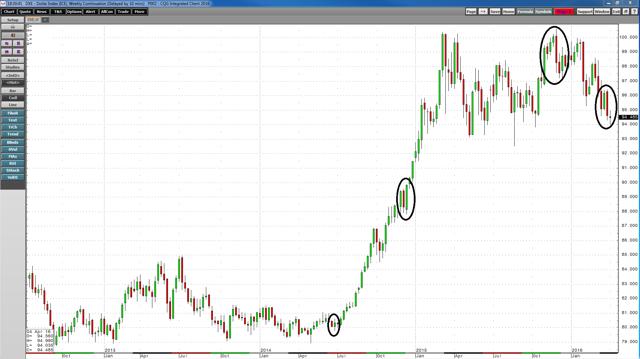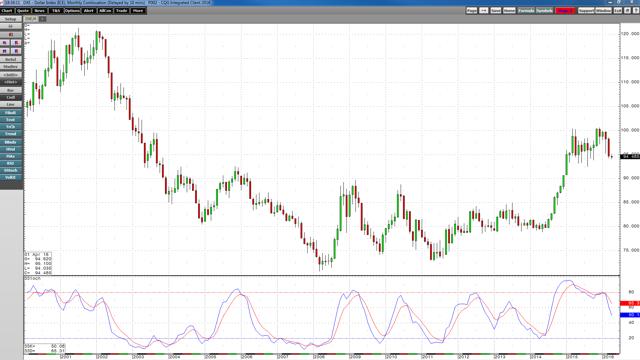Currencies tend to be less volatile than other assets over time. The quarterly historical volatility of the U.S. Dollar Index was 8.76% on April 7. The quarterly volatility of the euro currency and Japanese yen relationships with the dollar are 9.83% and 9.57%, respectively. Over past decades, the volatility level for these currencies, on a quarterly basis, never exceeded 16%. Although the same metric for the S&P 500 stood at only 7.93% during the first week of April 2016, this equity index traded at over 27% in 2010. The U.S. 30-year bond had a quarterly volatility of 11.58% as of the beginning of this month.
Commodities are more volatile assets. The quarterly volatility for crude oil is currently 36.1%, in gold it is 14.11% and corn stands at 29.82%. Higher volatility means wider price ranges. When it comes to currencies, central banks and monetary authorities around the world manage the relative value between their means of exchange. The mission of a central bank is to provide stability in markets. Currencies are backed by the full faith and credit of the governments that print paper notes. Therefore, it should come as no surprise that currency volatility is lower than virtually all other assets. This does not mean that they do not move. Over recent years, we have seen some big currencies move as central banks around the world have employed monetary policy in an attempt to stimulate lethargic economies around the globe.
A bull market in the dollar from May 2014
The global economic crisis that commenced in 2008 caused central banks around the world to redefine the tools at their disposal. Weak economic conditions and fears of a global depression introduced quantitative easing, or buying back government debt and expanding a country’s balance sheet to keep interest rates artificially low. At first, interest rate cuts to zero failed to jump-start the economic landscape. The U.S. Fed under the former Chairman Ben Bernanke, a student of the Great Depression, began the policy of QE and other central banks around the world have followed his lead. The U.S. economy improved. In May 2014, when it appeared that the worst was over for the U.S. economy, the dollar began to rise in value against other currencies around the world.

Between May 2014 and March 2015, the dollar moved from 78.93 on the active month dollar index futures contract all the way up to 100.38. The appreciation of more than 27% was a statement about the relative health of the U.S. economy. Since those highs, the dollar consolidated between 93.50 and 100.60 on the index. The lows came on August 24, 2015. On that day, the Chinese shocked the world with a currency devaluation of their yuan. The highs came at the end of November 2015 as the U.S. Federal Reserve prepared to increase the fed funds rate from the zero level for the first time in nine years. The nominal rate hike last December caused the dollar to move back towards the 100 level in early January and remain in bullish mode until March 10. The Fed had promised more rate hikes in 2016 at their December meeting.
On March 10, the European Central Bank fired a stimulative bazooka at the European economy. They increased their QE program from 60 billion to 80 billion euros each month and incorporated corporate debt into the program. At the same time, they lowered their short-term interest rate to -40 basis points. The ECB’s goal was to stimulate borrowing and spending and discourage saving. When the ECB stated that the rate cut would be their last, the dollar moved lower. The actions of the Europeans were bullish for the dollar. The interest rate gap between the dollar and euro widened with the dollar as the beneficiary. However, the market decided to focus on the statement rather than the actions and the dollar fell.
When the Fed did not increase rates at their March meeting, the dollar fell to a new short-term low. In the week that followed, several members of the FOMC stated that a rate hike was possible in April. However, Chairperson Janet Yellen then dispelled all notions of an increase in the fed funds rate at the April meeting in a speech before the Economic Club of New York. Citing concerns about economic weakness in Asia and Europe, Yellen reiterated the new Fed policy of “gradualism.” While the Fed had led us to believe that the next rate hike would be guided by U.S. economic data, it turns out that Yellen is seeing some warning signs on the global economic front that are giving her reason to pause.
The U.S. economy continues to be comparatively compelling
The U.S. economy is not growing at an accelerated pace and inflation measures remain below the central bank’s 2% target level. However, the fact that the U.S. economy is growing and the nation is close to or at full employment, according to the central bank’s method of calculation, the U.S. economy is in the best shape in the world as we enter the second quarter of 2016. All domestic economic metrics and data suggest that short-term interest rates below the 1% level are not justified. However, Asian contagion is on the Fed’s radar and that means that any interest rate hikes will come later in 2016, if at all.
We got the first taste of Asian contagion on August 24 when the dollar index fell to 93.50. The second came at the very start of 2016. The Chinese stock market plunged on the first trading day of the year. We got the third last week when the Japanese stated that they are prepared to slash interest rates further into negative territory to apply what amounts to a central bank defibrillator to their flat-lining economy. The sincere hope of the Abe government and the Central Bank of Japan was a weaker yen and an increase in the competitive position of Japanese exports. They got just the opposite.
It turns out that the yen-carry trade had many borrowing money in yen to invest in stocks around the world. The actions of the central bank caused unwinding of that trade by some market participants causing the value of the yen to soar.

As the chart of the yen-dollar relationship highlights, the yen exploded higher last week and this is bad news for an already ailing Japanese economy. I am shocked that the Japanese economic brain trust did not see that coming.
It seems that these days, central bank words are having more effects on markets than their actions. Mario Draghi saw his euro currency explode after he applied some of the most bearish monetary tools possible to his economy. The Japanese suffered the same fate last week. Meanwhile, the Fed is sitting back and watching all the action afraid to take steps instead adopting an approach of “gradualism.”
Central banks stomp on the greenback
In 2016, central banks around the world have either consciously or unconsciously stomped on the dollar. While economic growth continues to be weak across Asia and Europe and a strong dollar would increase exports and potentially jump start their economies, they are getting just the opposite effect from policy moves. The U.S. Fed’s inaction or “gradualism” or whatever you may wish to call it, appears to be rooted in the fear of contagion from Asia and the continent. Therefore, it now appears that U.S. monetary policy is not based on U.S. economic data but rather by decisions and conditions in Brussels, Tokyo, and Beijing.
I was a dollar bull until March. I sold my long positions in the dollar after the market reaction to Draghi’s euro bazooka. When a market reacts in a polar opposite fashion to an event, it often reveals true weakness in that market. Some traders like to call it buy the rumor and sell the fact. In the case of the dollar for me, it was a case of stay long for fundamental reasons. Those reasons were based on compelling interest rate differentials between a dollar with a yield and currencies that one could only hold at a cost. I got out when I realized fundamentals do not matter anymore; other forces are driving the path of least resistance for the U.S. currency.
Technicals are weak
On a purely technical basis, the dollar looks sick. During the final week of March, the greenback put in a bearish key-reversal trading pattern on the weekly chart. This technical pattern occurs when a market trades to a higher high than the previous week and closes below the previous week’s lows.
If we look back to the beginning of the bull market in the dollar index in May 2014, it was a bullish key reversal on the weekly chart during the week of June 30, 2014, that launched the dollar higher. Another bullish key reversal the week of December 15, 2014, caused another dramatic leg higher. The first bearish key-reversal came during the week of November 30, 2015. The index has never moved higher than it did that week and it followed through to the downside. The latest appearance of this bearish technical pattern came during the final week of March.

I have highlighted the key-reversals in the dollar index over the past two years. In every case, this technical pattern was followed by a significant move in the direction of the reversal. Moreover, the monthly chart indicates a compelling trend reversal for the dollar index as well.

The slow-stochastic, a momentum indicator, now tells us that the path of least resistance for the dollar is lower. Additionally, a bullish key-reversal pattern on the monthly chart in July 2014 was followed by the huge rally. In August 2015, the only other key-reversal was to the downside. History tends to repeat itself and the technical history of the dollar index is now flashing an ominous sell signal.
No hike, the dollar will take a hike
I am still scratching my bald head and wondering why the fundamentals for the dollar do not matter anymore. I have been scouring the markets looking for any signs of central bank intervention in the dollar to prove that the monetary authorities are behind the weakness that makes no sense to me on a relative interest rate or economic growth basis. Perhaps the dollar moved too far too fast for the central bankers who are determined to provide stability to markets even if it runs contrary to solid relative value analysis.
The dollar is now approaching important support at 93.50, the August 24, 2015, lows. If there is no Fed rate hike in April, the dollar could be toasted and roasted. As a fundamentalist, it is hard for me to embrace analysis that is purely technical. However, a 50% retracement of the move between the lows of May 2014 and the highs of December 2015 in the dollar index suggests that the dollar could be headed for a test of the 89.765 level.
I certainly hope that the central banks understand what is going on in the international currency markets. If they are as baffled as I am, then we could be in for some real problems and volatility in the global economy. Perhaps that is why the best performing asset these days is gold, the hybrid between a currency and commodity that the central banks of the world love to hate the most because they cannot print more. The dollar index closed on Friday, April 8 at 94.50 on the active month June futures contract, just one point above the entrance into the abyss of lower value. It is possible that gold understands more about the global economy at this point than me and all the central bankers in the world.
Disclosure: I/we have no positions in any stocks mentioned, and no plans to initiate any positions within the next 72 hours.
I wrote this article myself, and it expresses my own opinions. I am not receiving compensation for it (other than from Seeking Alpha). I have no business relationship with any company whose stock is mentioned in this article.
Additional disclosure: The author always has positions in gold that change with market conditions.
No comments:
Post a Comment